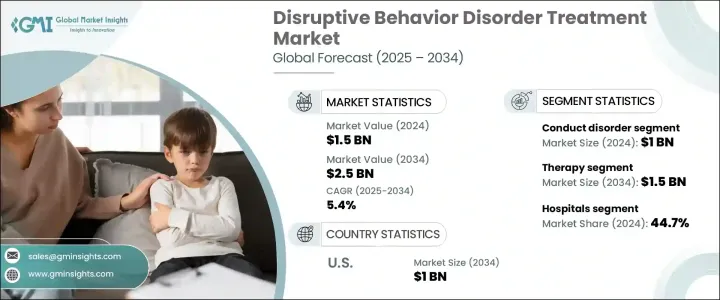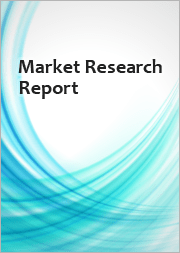
|
시장보고서
상품코드
1708189
세계의 파괴적 행동 장애(DBD) 치료 시장 기회, 성장 촉진요인, 산업 동향 분석 및 예측(2025-2034년)Disruptive Behavior Disorder Treatment Market Opportunity, Growth Drivers, Industry Trend Analysis, and Forecast 2025 - 2034 |
||||||
세계 파괴적 행동장애 치료 시장은 2024년 15억 달러 규모에 달할 것으로 예상되며, 2025년부터 2034년까지 연평균 5.4% 성장할 것으로 예측됩니다.
이 시장은 반항성 장애(ODD), 간헐적 폭발성 장애(IED), 품행장애(CD) 등 주로 소아 및 청소년이 앓고 있는 질환을 대상으로 하고 있습니다. 이러한 장애의 유병률 증가는 정신 건강에 대한 인식 증가와 함께 효과적인 치료 옵션에 대한 수요를 촉진하고 있습니다. 부모, 교육자, 의료진이 조기 개입의 중요성을 인식함에 따라 전문적인 치료의 필요성이 증가하고 있습니다.

또한, 행동 치료 및 약리학적 개입을 포함한 치료 방법의 발전으로 이러한 장애를 관리할 수 있는 보다 종합적인 솔루션이 제공되고 있습니다. 정신 건강 서비스 개선과 치료 접근성 향상을 위한 정부의 이니셔티브는 시장 성장을 더욱 촉진하고 있습니다. 증거 기반 치료의 중요성이 강조되고 새로운 치료법의 효과를 평가하는 임상 연구가 증가함에 따라 시장 확대에 크게 기여할 것으로 예측됩니다. 또한, 디지털 헬스 기술과 원격 치료 서비스의 통합으로 더 많은 사람들이 치료를 받을 수 있게 되면서 향후 몇 년 동안 더 많은 성장의 원동력이 될 것으로 보입니다.
| 시장 범위 | |
|---|---|
| 시작 연도 | 2024년 |
| 예측 연도 | 2025-2034년 |
| 시작 금액 | 15억 달러 |
| 예상 금액 | 25억 달러 |
| CAGR | 5.4% |
시장은 행동장애, 간헐적 폭발성 장애, 반항적 전도성 장애의 세 가지 주요 장애 유형으로 구분됩니다. 품행장애는 2024년 10억 달러 규모 시장을 창출하며 가장 큰 시장 점유율을 차지했습니다. 이러한 우위는 공격적, 파괴적, 반사회적 행동의 지속적인 패턴을 특징으로 하는 아동 및 청소년의 높은 유병률에 기인합니다. 이러한 행동은 항정신병 약물과 같은 약리학적 개입과 행동치료를 포함한 집중적인 치료가 필요한 경우가 많습니다. 개별화되고 다각적인 치료 옵션에 대한 수요가 증가함에 따라 이 분야의 꾸준한 성장에 박차를 가하고 있습니다.
파괴적 행동장애의 치료 옵션에는 약물 치료와 치료법이 있으며, 치료법이 시장을 주도하고 있습니다. 치료는 2024년 시장 점유율의 59.4%를 차지했고, 2034년까지 15억 달러에 달할 것으로 예측됩니다. 가족치료, 인지행동치료(CBT), 사회정서적 기술 훈련 등 다양한 치료 옵션이 있으며, 이들 모두 감정 조절을 다루고 가족 간의 관계를 개선하는 데 중요한 역할을 합니다. 치료는 여전히 가장 널리 사용되는 치료법이며, 정신 건강 전문가가 환자의 특정 요구에 맞게 개입하는 것이 가장 널리 사용되는 치료법입니다. 항정신병약물 및 ADHD 치료제를 포함한 약리학적 치료는 특히 행동적 개입만으로는 충분하지 않을 때 중요한 보조적 역할을 계속하고 있습니다.
미국의 파괴적 행동장애 치료 시장은 2023년 5억 8,070만 달러에 달했으며, 이는 진단 환자 수 증가와 헬스케어 혁신에 대한 지속적인 투자에 기인합니다. 정신 건강에 대한 관심이 높아지면서 보다 효과적인 치료법 개발이 시장의 지속적인 성장에 기여하고 있습니다. 연구 이니셔티브 증가와 함께 정신 건강 프로그램에 대한 자금 지원이 증가하면서 치료 옵션의 발전을 촉진하고 있습니다.
목차
제1장 조사 방법과 조사 범위
제2장 주요 요약
제3장 업계 인사이트
- 생태계 분석
- 업계에 대한 영향요인
- 성장 촉진요인
- 업계의 잠재적 리스크&과제
- 성장 가능성 분석
- 규제 상황
- 향후 시장 동향
- 갭 분석
- Porter's Five Forces 분석
- PESTEL 분석
제4장 경쟁 구도
- 서론
- 기업 점유율 분석
- 기업 매트릭스 분석
- 주요 시장 기업 - 경쟁 분석
- 경쟁 포지셔닝 매트릭스
- 전략 대시보드
제5장 시장 추산 및 예측 : 질환 유형별, 2021년-2034년
- 주요 동향
- 적대적 반향장애
- 행동 장애
- 간헐적 폭발 장애
제6장 시장 추산 및 예측 : 치료 유형별, 2021년-2034년
- 주요 동향
- 약제
- 항정신병제
- 각성제
- 비자극성 ADHD 치료제
- 기타 약제
- 요법
- 종합 평가
- 가족 치료
- 육아 방식 수정
- 그룹 치료
- 개인 치료
- 사회적 및 감정적 기술 훈련
제7장 시장 추산 및 예측 : 최종 용도별, 2021년-2034년
- 주요 동향
- 병원
- 정신과 클리닉
- 재활치료센터
- 기타 최종 용도
제8장 시장 추산 및 예측 : 지역별, 2021년-2034년
- 주요 동향
- 북미
- 미국
- 캐나다
- 유럽
- 독일
- 영국
- 프랑스
- 스페인
- 이탈리아
- 네덜란드
- 아시아태평양
- 중국
- 인도
- 일본
- 호주
- 한국
- 라틴아메리카
- 브라질
- 멕시코
- 아르헨티나
- 중동 및 아프리카
- 사우디아라비아
- 남아프리카공화국
- 아랍에미리트(UAE)
제9장 기업 개요
- 약제
- Bionomics
- Eli Lilly and Company
- Johnson & Johnson
- Mylan
- Novartis
- Pfizer
- Takeda Pharmaceuticals
- 요법
- Boston Children's Hospital
- Highland Ridge Hospital
- INTEGRIS Health
- Lakeview Health
- Springwoods Behavioral Health
The Global Disruptive Behavior Disorder Treatment Market generated USD 1.5 billion in 2024 and is projected to grow at a CAGR of 5.4% between 2025 and 2034. This market addresses conditions such as oppositional defiant disorder (ODD), intermittent explosive disorder (IED), and conduct disorder (CD), which primarily affect children and adolescents. The rising prevalence of these disorders, coupled with an increasing focus on mental health awareness, is driving the demand for effective treatment options. As parents, educators, and healthcare providers recognize the importance of early intervention, the need for specialized care is growing.

Moreover, advancements in treatment modalities, including behavioral therapies and pharmacological interventions, are offering more comprehensive solutions for managing these disorders. Government initiatives aimed at improving mental health services and increasing access to treatment are further boosting market growth. The growing emphasis on evidence-based therapies, coupled with an increasing number of clinical studies to evaluate the effectiveness of new treatments, is expected to contribute significantly to the market's expansion. Additionally, the integration of digital health technologies and teletherapy services is making treatment more accessible to a wider demographic, driving further growth in the coming years.
| Market Scope | |
|---|---|
| Start Year | 2024 |
| Forecast Year | 2025-2034 |
| Start Value | $1.5 Billion |
| Forecast Value | $2.5 Billion |
| CAGR | 5.4% |
The market is segmented into three primary disorder types: conduct disorder, intermittent explosive disorder, and oppositional defiant disorder. Conduct disorder accounted for the largest share of the market, generating USD 1 billion in 2024. This dominance is attributed to the high prevalence of the disorder among children and adolescents, characterized by persistent patterns of aggressive, disruptive, and antisocial behaviors. These behaviors often necessitate intensive treatment involving both pharmacological interventions, such as antipsychotic medications, and behavioral therapies. The increasing need for personalized and multi-faceted treatment options has fueled the steady growth of this segment.
Treatment options for disruptive behavior disorders include both medications and therapy, with the therapy segment dominating the market. Therapy accounted for 59.4% of the market share in 2024 and is expected to generate USD 1.5 billion by 2034. Therapy options are extensive and include family therapy, cognitive-behavioral therapy (CBT), and social-emotional skills training, all of which play a crucial role in addressing emotional regulation and improving family dynamics. Therapy remains the most widely utilized treatment approach, with mental health professionals tailoring interventions to meet the specific needs of affected individuals. Pharmacological treatments, including antipsychotics and ADHD medications, continue to serve as valuable adjuncts, particularly in cases where behavioral interventions alone are insufficient.
The U.S. disruptive behavior disorder treatment market generated USD 580.7 million in 2023, driven by a growing number of diagnosed individuals and the country's ongoing investment in healthcare innovations. As the focus on mental health intensifies, the development of more effective therapies is contributing to sustained market growth. Increased funding for mental health programs, coupled with a rise in research initiatives, is fostering the advancement of treatment options, ensuring continuous improvements in care delivery across the country.
Table of Contents
Chapter 1 Methodology and Scope
- 1.1 Market scope and definitions
- 1.2 Research design
- 1.2.1 Research approach
- 1.2.2 Data collection methods
- 1.3 Base estimates and calculations
- 1.3.1 Base year calculation
- 1.3.2 Key trends for market estimation
- 1.4 Forecast model
- 1.5 Primary research and validation
- 1.5.1 Primary sources
- 1.5.2 Data mining sources
Chapter 2 Executive Summary
- 2.1 Industry 360° synopsis
Chapter 3 Industry Insights
- 3.1 Industry ecosystem analysis
- 3.2 Industry impact forces
- 3.2.1 Growth drivers
- 3.2.1.1 Rising prevalence of behavioral disorders
- 3.2.1.2 Integration of digital therapeutics
- 3.2.1.3 Increasing awareness and early diagnosis
- 3.2.1.4 Evolving government policies and support
- 3.2.2 Industry pitfalls and challenges
- 3.2.2.1 Social stigma associated with mental health disorders
- 3.2.1 Growth drivers
- 3.3 Growth potential analysis
- 3.4 Regulatory landscape
- 3.5 Future market trends
- 3.6 Gap analysis
- 3.7 Porter's analysis
- 3.8 PESTEL analysis
Chapter 4 Competitive Landscape, 2024
- 4.1 Introduction
- 4.2 Company market share analysis
- 4.3 Company matrix analysis
- 4.4 Competitive analysis of major market players
- 4.5 Competitive positioning matrix
- 4.6 Strategy dashboard
Chapter 5 Market Estimates and Forecast, By Disorder Type, 2021 – 2034 ($ Mn)
- 5.1 Key trends
- 5.2 Oppositional defiant disorder
- 5.3 Conduct disorder
- 5.4 Intermittent explosive disorder
Chapter 6 Market Estimates and Forecast, By Treatment Type, 2021 – 2034 ($ Mn)
- 6.1 Key trends
- 6.2 Drugs
- 6.2.1 Antipsychotics
- 6.2.2 Stimulants
- 6.2.3 Non-stimulant ADHD medications
- 6.2.4 Other drugs
- 6.3 Therapy
- 6.3.1 Comprehensive evaluation
- 6.3.2 Family therapy
- 6.3.3 Parenting modification
- 6.3.4 Group therapy
- 6.3.5 Individual therapy
- 6.3.6 Social and emotional skills training
Chapter 7 Market Estimates and Forecast, By End Use, 2021 – 2034 ($ Mn)
- 7.1 Key trends
- 7.2 Hospitals
- 7.3 Psychiatric clinics
- 7.4 Rehabilitation centers
- 7.5 Other end use
Chapter 8 Market Estimates and Forecast, By Region, 2021 – 2034 ($ Mn)
- 8.1 Key trends
- 8.2 North America
- 8.2.1 U.S.
- 8.2.2 Canada
- 8.3 Europe
- 8.3.1 Germany
- 8.3.2 UK
- 8.3.3 France
- 8.3.4 Spain
- 8.3.5 Italy
- 8.3.6 Netherlands
- 8.4 Asia Pacific
- 8.4.1 China
- 8.4.2 India
- 8.4.3 Japan
- 8.4.4 Australia
- 8.4.5 South Korea
- 8.5 Latin America
- 8.5.1 Brazil
- 8.5.2 Mexico
- 8.5.3 Argentina
- 8.6 Middle East and Africa
- 8.6.1 Saudi Arabia
- 8.6.2 South Africa
- 8.6.3 UAE
Chapter 9 Company Profiles
- 9.1 Drugs:
- 9.1.1 Bionomics
- 9.1.2 Eli Lilly and Company
- 9.1.3 Johnson & Johnson
- 9.1.4 Mylan
- 9.1.5 Novartis
- 9.1.6 Pfizer
- 9.1.7 Takeda Pharmaceuticals
- 9.2 Therapy:
- 9.2.1 Boston Children's Hospital
- 9.2.2 Highland Ridge Hospital
- 9.2.3 INTEGRIS Health
- 9.2.4 Lakeview Health
- 9.2.5 Springwoods Behavioral Health



















